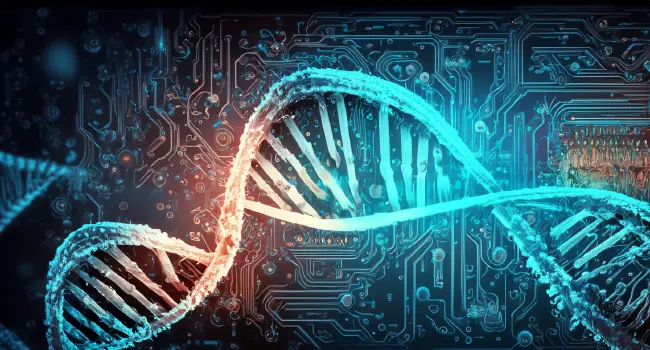DNA Computing & Biocomputing: The Intersection of Biology and Technology
Uncategorized

The field of DNA computing and biocomputing is an innovative and rapidly advancing area at the crossroads of biology and information technology. It explores the potential of using biological molecules—particularly DNA—as a medium for performing computational processes. Unlike traditional computing, which relies on silicon-based processors, DNA computing harnesses the power of organic molecules to solve complex problems, offering revolutionary possibilities for data storage, processing, and analysis.
For students interested in exploring emerging technologies and the future of computing, enrolling in the top college in Haryana for BBA provides a unique opportunity. A strong foundation in business administration combined with an understanding of cutting-edge scientific innovations like DNA computing can prepare students for careers in industries that bridge technology, business, and biotechnology.
What is DNA Computing?
DNA computing is a type of unconventional computing where DNA, biochemistry, and molecular biology are used to perform computational operations. The concept was first proposed by Leonard Adleman in 1994, who demonstrated that DNA could be used to solve a mathematical problem known as the Hamiltonian Path problem. Since then, DNA computing has gained significant attention for its potential to perform massively parallel computations in a tiny space, utilizing the natural properties of DNA molecules.
In traditional computing, data is represented in binary format—0s and 1s—while in DNA computing, information is encoded using the four chemical bases of DNA: adenine (A), cytosine (C), guanine (G), and thymine (T). These bases can be arranged in different sequences to represent data, and the interactions between DNA strands can be manipulated to execute logical operations.
The main advantage of DNA computing is its ability to perform massively parallel computations. A single gram of DNA can hold the equivalent of 10^21 bytes of data, providing a vast potential for both storage and processing. Unlike traditional silicon-based computers, which process information sequentially or with limited parallelism, DNA computing leverages the biochemical properties of DNA molecules to perform trillions of computations simultaneously. This parallelism makes DNA computing highly efficient for solving complex problems, such as combinatorial optimization and cryptographic analysis, which would take traditional computers years to compute.
One of the most notable demonstrations of DNA computing was performed by Leonard Adleman in 1994 when he used DNA to solve the Hamiltonian Path Problem, a classic example of NP-complete problems. By encoding possible solutions into DNA strands and utilizing natural molecular reactions to eliminate incorrect paths, he demonstrated how DNA computing could solve complex problems in a fraction of the time required by conventional computers.
Additionally, DNA computing is highly energy-efficient compared to electronic computing. DNA reactions occur naturally and require minimal external power, making them a sustainable alternative. While still in its early stages, advancements in DNA computing could revolutionize fields like cryptography, bioinformatics, and artificial intelligence by providing unprecedented computational power in a molecular-scale system.
How Does DNA Computing Work?
DNA computing relies on the principles of molecular biology and chemistry to manipulate DNA molecules to perform specific tasks. The basic steps involved in DNA computing include:
- Encoding Information: In DNA computing, data is encoded into DNA sequences. The four bases of DNA (A, C, G, T) are used to represent binary data. For example, A could represent 0, and T could represent 1, or any other combination based on the encoding scheme.
- DNA Manipulation: Once the information is encoded, it is processed by performing various biochemical operations on the DNA molecules. These operations include ligation (joining DNA strands), hybridization (binding complementary DNA strands), and polymerase chain reactions (PCR), which amplify specific DNA sequences to carry out the necessary computation.
- Solution Extraction: After the DNA molecules interact, the solutions are extracted and analyzed. The results are usually obtained through techniques like gel electrophoresis, which separates DNA fragments based on their size, or by sequencing the DNA to decode the final answer.
- Massive Parallelism: One of the key features of DNA computing is the ability to perform computations in parallel. DNA molecules can interact with each other simultaneously in a test tube, solving many possible solutions to a problem at the same time. This allows DNA computing to explore a vast number of potential solutions much faster than traditional sequential computing.
Applications of DNA Computing
- Cryptography and Security: DNA computing has potential applications in the field of cryptography. The complex molecular interactions involved in DNA computing could be used to create secure encryption systems. By encoding cryptographic keys in DNA sequences, one can create virtually unbreakable encryption methods that are highly resistant to hacking and computational attacks.
- Data Storage: One of the most exciting applications of DNA computing is its potential for data storage. DNA has a density of storage that is far superior to current technologies. A gram of DNA can theoretically store up to 215 petabytes (215 million gigabytes) of data. As the demand for data storage grows exponentially, DNA-based storage systems could offer a viable solution for storing vast amounts of information in a compact and efficient manner.
- Optimization Problems: DNA computing can be used to solve combinatorial optimization problems, such as the traveling salesman problem or the knapsack problem. These types of problems are difficult for classical computers to solve efficiently, especially as the size of the problem increases. DNA computing can exploit the massive parallelism of molecular interactions to explore all possible solutions at once, dramatically speeding up the process.
- Biotechnology and Medicine: In the field of biotechnology, DNA computing can assist in drug discovery, protein folding, and genetic research. It can also be used to simulate biological processes, allowing scientists to model and analyze complex biological systems at a molecular level. DNA-based computing systems could lead to breakthroughs in personalized medicine, genetic engineering, and disease prevention.
- Artificial Intelligence and Machine Learning: DNA computing could have applications in artificial intelligence (AI) and machine learning by enabling more efficient processing of large datasets. DNA’s ability to solve problems in parallel could accelerate the training of AI models, allowing them to process more data and develop more accurate models in less time.
Biocomputing: The Next Frontier
Biocomputing is an extension of DNA computing, using biological molecules to create more advanced computing systems. While DNA computing primarily focuses on using DNA for information processing, biocomputing explores the broader concept of using other biological molecules, such as proteins and enzymes, for computational tasks.
Biocomputing draws inspiration from natural biological systems to create new kinds of computational devices that operate based on principles of biology. These devices can potentially use biochemical reactions, molecular recognition, and bio-molecular computing to solve computational problems. By utilizing biological materials, biocomputing systems may be able to achieve new levels of efficiency, energy consumption, and scalability.
Advantages of DNA Computing and Biocomputing
- Massive Parallelism: DNA computing and biocomputing systems can perform calculations in parallel at a scale that far exceeds traditional computing systems. This parallelism allows for rapid processing of large datasets and complex problems.
- Energy Efficiency: Biological systems naturally consume very little energy, and DNA computing takes advantage of this. Traditional computers consume large amounts of energy for computations, whereas DNA-based systems can operate using minimal energy and at a much lower cost.
- Storage Density: As mentioned earlier, DNA has an incredibly high storage density, which makes it an ideal medium for data storage. This could be a game-changer in the era of big data and data centers.
- Scalability: The scalability of DNA computing allows it to potentially solve larger and more complex problems that traditional computing systems may struggle with. As biocomputing technologies evolve, we may see more advanced systems that can handle increasingly sophisticated tasks.
The Future of DNA Computing and Biocomputing
The future of DNA computing and biocomputing is incredibly promising, with the potential to revolutionize industries ranging from biotechnology to cybersecurity. While DNA computing has already shown success in small-scale applications, the challenge lies in scaling up the technology and integrating it with existing systems. However, researchers are making significant strides in advancing this field, and it’s only a matter of time before DNA computing becomes more widely used in real-world applications.
Why Should Students Explore DNA Computing?
For students pursuing a BBA degree, having knowledge of emerging technologies like DNA computing and biocomputing can provide valuable insights into how technology is transforming the business landscape. Understanding the potential impact of DNA computing on industries such as data storage, encryption, and biotechnology can give students an edge in future careers where business and technology intersect.
The top college in Haryana for BBA can help students develop critical thinking, problem-solving, and leadership skills, which are essential for navigating the future of business and technology. By incorporating knowledge of innovative fields like DNA computing into their education, students can position themselves at the forefront of the next technological revolution.
Conclusion
DNA computing and biocomputing are at the cutting edge of technological innovation, offering groundbreaking solutions for problems that are difficult or impossible to solve using traditional computing methods. As these technologies continue to develop, they have the potential to transform industries ranging from data storage to biotechnology. For students pursuing a BBA, understanding these emerging fields can enhance their interdisciplinary knowledge and prepare them for the exciting opportunities that lie ahead in the world of technology and business.
